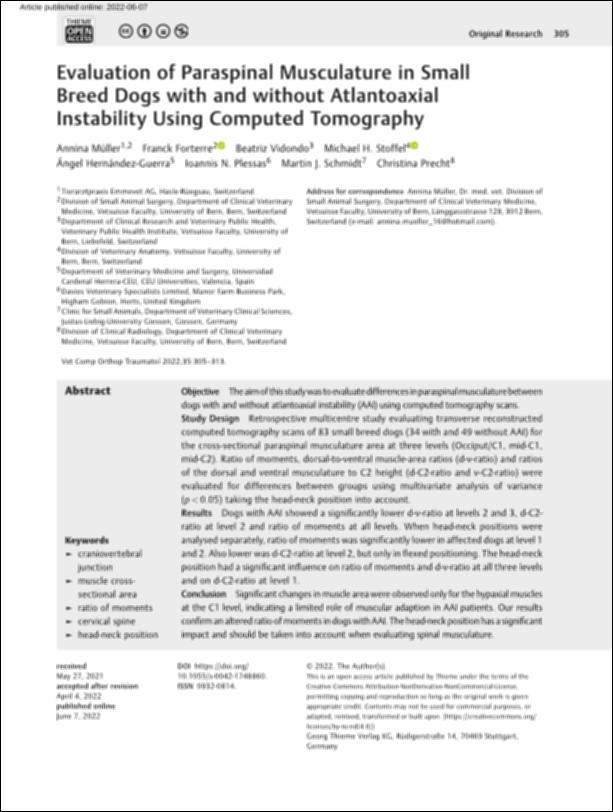Please use this identifier to cite or link to this item:
http://hdl.handle.net/10637/14446Evaluation of paraspinal musculature in small breed dogs with and without atlantoaxial instability using computed tomography
| Title: | Evaluation of paraspinal musculature in small breed dogs with and without atlantoaxial instability using computed tomography |
| Authors : | Müller, Annina Forterre, Franck Vidondo Currás, Beatriz Stoffel, Michael H. Hernández Guerra, Ángel María Plessas, Ioannis N. |
| Keywords: | Perros - Sistema musculoesquelético - Tomografía.; Radiología veterinaria.; Dogs - Musculoskeletal system - Tomography.; Autoimmune diseases - Treatment.; Veterinary radiology.; Enfermedades autoinmunes - Tratamiento. |
| Publisher: | Georg Thieme |
| Citation: | Müller, A., Forterre, F., Vidondo, B., Stoffel, M. H., Hernández-Guerra, Á., Plessas, I. N., Schmidt, M. J. & Precht, C. (2022). Evaluation of paraspinal musculature in small breed dogs with and without atlantoaxial instability using computed tomography. Veterinary and Comparative Orthopaedics and Traumatology, vol. 35, i. 5 (sep.), pp. 305–313. DOI: https://doi.org/10.1055/s-0042-1748860 |
| Abstract: | Objective: The aim of this study was to evaluate differences in paraspinal musculature between dogs with and without atlantoaxial instability (AAI) using computed tomography scans. Study Design Retrospective multicentre study evaluating transverse reconstructed computed tomography scans of 83 small breed dogs (34 with and 49 without AAI) for the cross-sectional paraspinal musculature area at three levels (Occiput/C1, mid-C1, mid-C2). Ratio of moments, dorsal-to-ventral muscle-area ratios (d-v-ratio) and ratios of the dorsal and ventral musculature to C2 height (d-C2-ratio and v-C2-ratio) were evaluated for differences between groups using multivariate analysis of variance (p<0.05) taking the head-neck position into account. Results Dogs with AAI showed a significantly lower d-v-ratio at levels 2 and 3, d-C2- ratio at level 2 and ratio of moments at all levels. When head-neck positions were analysed separately, ratio of moments was significantly lower in affected dogs at level 1 and 2. Also lower was d-C2-ratio at level 2, but only in flexed positioning. The head-neck position had a significant influence on ratio of moments and d-v-ratio at all three levels and on d-C2-ratio at level 1. Conclusion Significant changes inmuscle areawere observed only for the hypaxialmuscles at the C1 level, indicating a limited role of muscular adaption in AAI patients. Our results confirman altered ratio ofmoments in dogswithAAI. Thehead-neck position has a significant impact and should be taken into account when evaluating spinal musculature. |
| Description: | Este artículo se encuentra disponible en la siguiente URL: https://www.thieme-connect.com/products/ejournals/pdf/10.1055/s-0042-1748860.pdf En este artículo de investigación también participan: Martin J. Schmidt y Christina Precht. |
| URI: | http://hdl.handle.net/10637/14446 |
| Rights : | http://creativecommons.org/licenses/by-nc-nd/4.0/deed.es |
| ISSN: | 0932-0814 |
| Language: | es |
| Issue Date: | 16-Sep-2022 |
| Center : | Universidad Cardenal Herrera-CEU |
| Appears in Collections: | Dpto. Medicina y Cirugía Animal |
Items in DSpace are protected by copyright, with all rights reserved, unless otherwise indicated.


